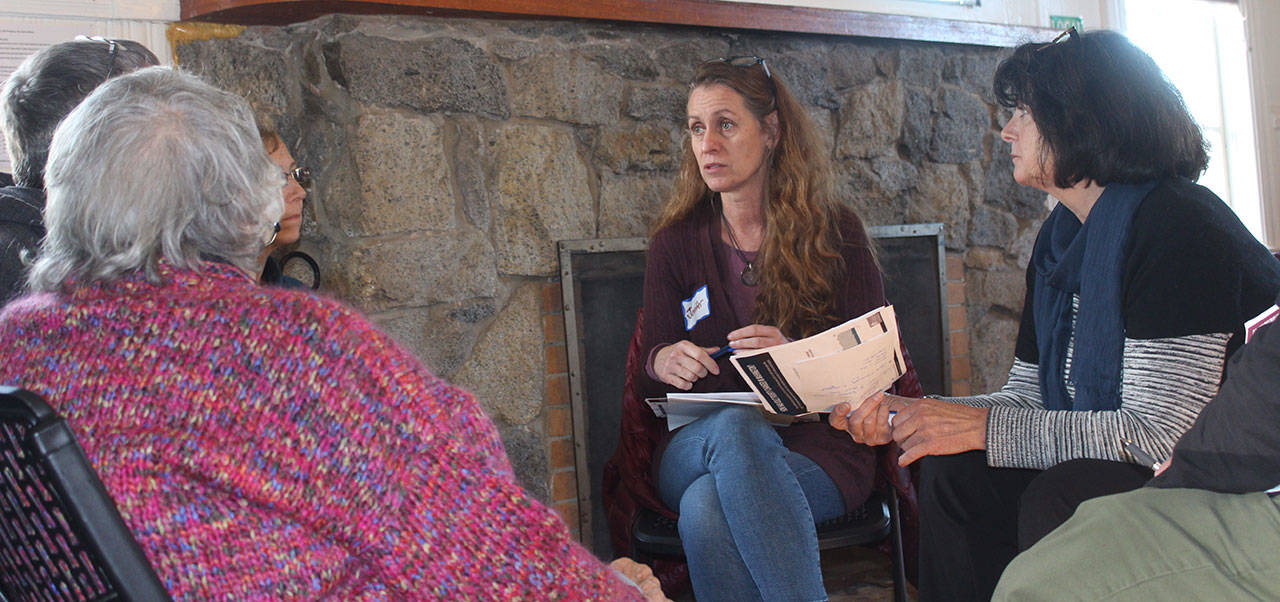Behind the million-dollar homes and celebrity residents of the San Juan Islands, citizens are struggling to make ends meet, just like the rest of Washington.
The state is searching for personalized solutions in each individualized community, like San Juan, to decrease poverty in Washington as a whole.
On Nov. 6, roughly 30 islanders, including representatives from nonprofits and government agencies, brainstormed ways to fight the same problems contributing to poverty statewide that are in locals’ own backyards.
Local problems identified at the meeting included the lack of affordable housing, high-wage jobs, medical and child care providers and state tax reform.
State’s poverty solution
Low wages and a high cost of living can be seen across Washington, but attendees explained that those problems are exacerbated in San Juan County. According to data provided at the meeting from the University of Washington, San Juan has the fifth-highest annual cost of living for a family of three out of the state’s 39 counties.
Nearly one in three Washingtonians use services provided by the Washington Department of Social and Health Services, which hosted the Nov. 6 forum, including assistance for food, child support and employment transitions.
Lori Pfingst, with DSHS, said the organization is looking to cut the state’s poverty in half within the next six years. According to the University of Washington, about 11 percent of residents lived in poverty as of 2016. The federal poverty level for a family of three, at that time, was an annual income of $20,160.
To lower poverty, Pfingst said DSHS needs targeted solutions for the varied populations served by the department — from the single mother in an urban city to the working families of rural areas like the San Juans.
For instance, for every $100 raised in rent across Washington state, Pfingst said the department sees a 6 percent increase in homelessness in urban areas but a 33 percent increase in rural regions.
“We bring [information] back to our leadership, and we make recommendations based on what we hear,” she said. “One blanket solution isn’t going to work for everyone.”
San Juan is the 12th county in Washington that department staff have visited since June 2017. They plan to return to work with locals to implement ideas.
Housing, jobs and health care
Greg Winter, with the regional housing nonprofit the Opportunity Council, recommended state and federal investments support affordable rentals as they do for roads and bridges.
“To me, it helps to think of affordable rental housing as infrastructure, the same way we think of our roads, bridges [and] water systems,” said Winter. “Affordable rental housing provides those same services of commerce, economic development and health and safety.”
Minnie Knych, who manages the local office of a regional workforce development organization, suggested county staff stop promoting local tourism. Tourism, she said, creates low-wage, seasonal jobs in sectors like food services and sales. Instead, the county government should boost permanent, higher-wage local industries, like manufacturing, that could support year-round residents.
Others proposed San Juan Island needs dental and vision providers that accept Medicaid and free preschool or year-round schools for parents who cannot afford child care while they work.
Tax issues
Attendees also discussed tax reform that could alleviate poverty.
Town of Friday Harbor Councilwoman Barbara Starr said 50 percent of the town does not pay property taxes, including the Port of Friday Harbor. She said this inequality in fees burdens those who pay property taxes, as they are covering the town’s expenses, while half of the town’s residents receive services for free.
However, San Juan County Health and Community Services Director Mark Tompkins noted that the county has a low property tax rate, compared to the rest of the state.
Pfingst added that Washington state has “the most regressive tax system in the country,” which charges middle- and low-income residents more than the upper class. According to the Institute on Taxation and Economic Policy, the majority of Washington state taxes comes from those who earn $24,000 a year or less. In Washington, sales and property are taxed but not income.
Policy changes could arise from a 45-member poverty reduction work group created by Washington state Gov. Jay Inslee. This group is comprised of tribes, community-based organizations and agencies, including DSHS, and was formed in 2017. One goal set by the governor’s office, which DSHS staff is working on, is to increase the number of people who voluntarily leave public assistance by 4 percent in 2019.
“A lot of people … are working on this issue and have accountability to the governor for poverty reduction,” said Pfingst. “I see a real opportunity to do things differently than we’ve done before.”
Changes, she said, include the state’s new approach to question those in poverty to find solutions that work for them.
“We have not looked at people who experience these issues as experts in their our lives,” said Pfingst. “We judge people who experience poverty; we don’t look to them for answers. That doesn’t work.”



